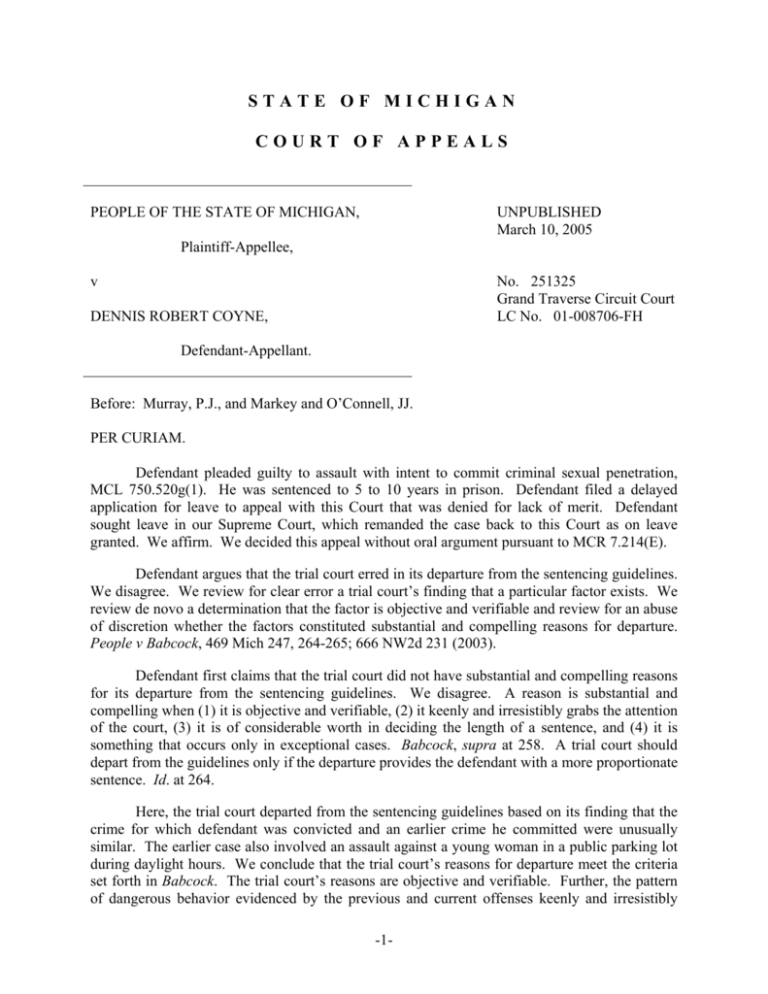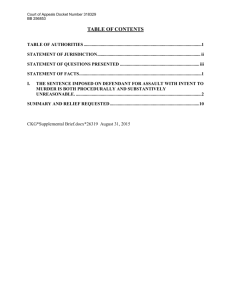state of michigan court of appeals
advertisement

STATE OF MICHIGAN COURT OF APPEALS PEOPLE OF THE STATE OF MICHIGAN, UNPUBLISHED March 10, 2005 Plaintiff-Appellee, v No. 251325 Grand Traverse Circuit Court LC No. 01-008706-FH DENNIS ROBERT COYNE, Defendant-Appellant. Before: Murray, P.J., and Markey and O’Connell, JJ. PER CURIAM. Defendant pleaded guilty to assault with intent to commit criminal sexual penetration, MCL 750.520g(1). He was sentenced to 5 to 10 years in prison. Defendant filed a delayed application for leave to appeal with this Court that was denied for lack of merit. Defendant sought leave in our Supreme Court, which remanded the case back to this Court as on leave granted. We affirm. We decided this appeal without oral argument pursuant to MCR 7.214(E). Defendant argues that the trial court erred in its departure from the sentencing guidelines. We disagree. We review for clear error a trial court’s finding that a particular factor exists. We review de novo a determination that the factor is objective and verifiable and review for an abuse of discretion whether the factors constituted substantial and compelling reasons for departure. People v Babcock, 469 Mich 247, 264-265; 666 NW2d 231 (2003). Defendant first claims that the trial court did not have substantial and compelling reasons for its departure from the sentencing guidelines. We disagree. A reason is substantial and compelling when (1) it is objective and verifiable, (2) it keenly and irresistibly grabs the attention of the court, (3) it is of considerable worth in deciding the length of a sentence, and (4) it is something that occurs only in exceptional cases. Babcock, supra at 258. A trial court should depart from the guidelines only if the departure provides the defendant with a more proportionate sentence. Id. at 264. Here, the trial court departed from the sentencing guidelines based on its finding that the crime for which defendant was convicted and an earlier crime he committed were unusually similar. The earlier case also involved an assault against a young woman in a public parking lot during daylight hours. We conclude that the trial court’s reasons for departure meet the criteria set forth in Babcock. The trial court’s reasons are objective and verifiable. Further, the pattern of dangerous behavior evidenced by the previous and current offenses keenly and irresistibly -1- grabs the attention. In fact, the trial court stated that it could not recall ever sentencing someone for “two assaults of this type in public settings on young women.” The obvious pattern to defendant’s crimes indicates an impulsive proclivity that properly carried considerable weight in determining the appropriate length of defendant’s sentence. Finally, the similarities in the crimes are extraordinary, so this qualifies as an exceptional case to which the guidelines do not neatly apply. Furthermore, as discussed below, the sentencing guidelines did not account for defendant’s earlier conviction at all. Therefore, the trial court did not abuse its discretion when it determined that the similarity between the two crimes served as a substantial and compelling reason to depart from the sentencing guidelines. Next, defendant claims that the trial court erred by basing its guidelines departure on defendant’s prior conviction, because consideration of the earlier conviction violated MCL 769.34(3)(b). Defendant argues that the Legislature specifically excluded the earlier conviction as a factor in determining defendant’s sentence because the crime occurred before the five-year period in MCL 769.34(3)(b). We disagree. The trial court cannot base its departure on “an offense characteristic or offender characteristic already taken into account in determining the appropriate sentencing range unless the court finds from the facts contained in the court record, including the presentence investigation report, that the characteristic has been given inadequate or disproportionate weight.” MCL 769.34(3)(b). Here, the trial court concluded that the sentencing guidelines’ factors did not adequately address the risk presented by defendant, and that the resultant statutory sentence failed to provide proportionate punishment or protection for the community. Under the sentencing guidelines, a continuing pattern of criminal behavior is determined by only considering crimes occurring within a five-year period. MCL 777.43(2)(a). Because defendant’s prior crime did not fall within the five-year period, the court did not score defendant under that offense variable, and defendant’s pattern of criminal behavior was not “taken into account,” under MCL 769.34(3)(b). Under these circumstances, the trial court properly determined that defendant’s sentence should reflect the obvious existence of the criminal pattern. Without a departure by the trial court, defendant’s pattern of dangerous behavior and the risk that he poses to young women would not have been factored into his sentence and would have led to a disproportionately low sentence. Therefore, the trial court did not violate any statutory restrictions when it based its departure on an underscored variable. Finally, we reject defendant’s assertion that his sentence violates the rule of Blakely v Washington, 542 US___; 124 S Ct 2531, 2536; 159 L Ed 2d 403 (2004). As our Supreme Court recognized in People v Claypool, 470 Mich 715, 731 n 14; 684 NW2d 278 (2004), the Blakely decision specifically excluded indeterminate sentencing from its ambit, because indeterminate sentencing does not improperly increase the maximum sentence, but rather, it adjusts the minimum sentence.1 Moreover, defendant’s sentence was a departure from the sentencing 1 Although not raised by defendant, we do not believe this issue is affected by US v Booker, ___ US ___; 125 S Ct 738, 746; ___ L Ed 2d ___ (2005), which also involved a mandatory increase in a defendant’s maximum sentence. -2- guidelines, so unlike the sentence in Blakely, the trial court, not the Legislature, determined the appropriate sentence. Affirmed. /s/ Christopher M. Murray /s/ Jane E. Markey /s/ Peter D. O’Connell -3-









